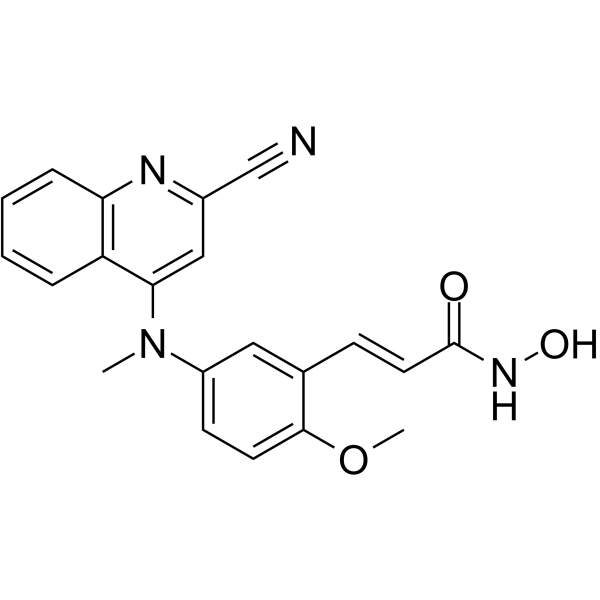Tubulin/HDAC-IN-1
Modify Date: 2025-09-23 17:58:23

Tubulin/HDAC-IN-1 structure
|
Common Name | Tubulin/HDAC-IN-1 | ||
|---|---|---|---|---|
| CAS Number | 2413587-26-3 | Molecular Weight | 374.39 | |
| Density | N/A | Boiling Point | N/A | |
| Molecular Formula | C21H18N4O3 | Melting Point | N/A | |
| MSDS | N/A | Flash Point | N/A | |
Use of Tubulin/HDAC-IN-1Tubulin/HDAC-IN-1 is a dual tubulin and HDAC-IN-1 inhibitor through CH/π interaction with tubulin and hydrogen bond interaction with HDAC8. Tubulin/HDAC-IN-1 inhibits tubulin polymerization and selectively inhibits HDAC8 (IC50: 150 nM). Tubulin/HDAC-IN-1 has cytotoxicity against various human cancer cells, also arrests cell cycle in the G2/M phase and induces cell apoptosis. Tubulin/HDAC-IN-1 can be used in the research of hematologic and solid tumors such as neuroblastoma, leukemia[1]. |
| Name | Tubulin/HDAC-IN-1 |
|---|
| Description | Tubulin/HDAC-IN-1 is a dual tubulin and HDAC-IN-1 inhibitor through CH/π interaction with tubulin and hydrogen bond interaction with HDAC8. Tubulin/HDAC-IN-1 inhibits tubulin polymerization and selectively inhibits HDAC8 (IC50: 150 nM). Tubulin/HDAC-IN-1 has cytotoxicity against various human cancer cells, also arrests cell cycle in the G2/M phase and induces cell apoptosis. Tubulin/HDAC-IN-1 can be used in the research of hematologic and solid tumors such as neuroblastoma, leukemia[1]. |
|---|---|
| Related Catalog | |
| Target |
HDAC8:150 nM (IC50) HDAC6:1 μM (IC50) HDAC11:1.9 μM (IC50) |
| In Vitro | Tubulin/HDAC-IN-1 (Compound 12a, 72 h) shows cytotoxicity against various human cancer cell lines with an averaged IC50 value of 0.6 nM[1]. Tubulin/HDAC-IN-1 (2 nM, 24 h) induces HT29 cell cycle arrest in the G2/M phase and produces caspase-induced apoptosis of HT29 cells through mitochondrial dysfunction[1]. Tubulin/HDAC-IN-1 selectively inhibits HDAC8 (IC50: 150 nM), inhibits HDAC6 and HDAC11 with IC 50 values of 1 μM and 1.9 μM respectively[1]. Tubulin/HDAC-IN-1 (0.5-100 nM, 24 h/30 min) dose-dependently increases γH2AX level and acetylated SMC3 in HT-29 cells[1]. Tubulin/HDAC-IN-1 (5-15 μΜ, 0-40 min) inhibits tubulin polymerization in a dose-dependent manner, with a maximal effect achieved at 10 μM[1]. Tubulin/HDAC-IN-1 (250 nM, 30 min) depolymerizes the cell microtubule network, and the effect is not specific[1]. Tubulin/HDAC-IN-1 shows good in vitro metabolic stability expressed by the intrinsic clearance CLint (given in μL/min/mg protein) using rat liver microsomes (RLM) and human liver microsomes (HLM)[1]. Compound RLM RLM HLM HLM t1/2 (h) CLint t1/2 CLint Tubulin/HDAC-IN-1 6.6 1.75 32 0.36 Cell Proliferation Assay[1] Cell Line: Various tumor cell lines as below Concentration: Incubation Time: 72 h Result: Activities of Tubulin/HDAC-IN-1 (Compound 12a) against various tumor cell lines (IC50 nM): NCIN87 K562 K562R MiaPaca2 SKOV3 A549 MCF-7 MDA-MB-231 HCT116 HT-29 Tubulin/HDAC-IN-1 0.1 0.35 0.56 0.94 0.6 0.84 0.78 0.7 0.6 0.62 Western Blot Analysis[1] Cell Line: HT-29 cells Concentration: 0.5, 1, 5, 10 nM for γH2AX; 0.5, 1, 100 nM for acetylated SMC3 Incubation Time: 24 h for γH2AX, 30 min for acetylated SMC3 Result: Dose-dependently increased γH2AX level and acetylated SMC3. |
| In Vivo | Tubulin/HDAC-IN-1 (Compound 12a, intratumoral injection, 0.25 mg/kg, three times a week for two weeks) decreases MCA205 tumor growth and extends the overall survival of treated mice in allogeneic sarcoma mice model[1]. Animal Model: Allogeneic sarcoma model in C57BL/6 mice[1] Dosage: 0.1, 0.25, 0.50 mg/kg, three times a week for two weeks. Administration: Intratumoral injection Result: Decreased tumor growth and extended the overall survival of treated mice with no obvious side effects. |
| References |
| Molecular Formula | C21H18N4O3 |
|---|---|
| Molecular Weight | 374.39 |